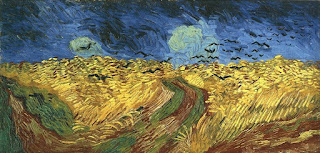On Thursday, I attended the Julio Fine Arts Gallery exhibit titled Uncertain Passages by Jay Gould. Gould has a M.F.A in photography from Savannah College of Art & Design and teaches at Maryland Institute College of Art. I was able to hear Gould speak about his pieces some, which was interesting to hear the thoughts behind the pieces. I thought it was especially interesting how Gould spoke about when he creates pieces he thinks about art and science. At first, when looking at Gould's pieces some looked like ordinary photographs of nature such as the one pictured below. At first glance it looks like a nice picture of a landscape focused on a tree in the center. Though by having this one tree capture the viewer's attention leads the viewer's eye to then notice and focus on the out of place smoke/cloud shape hovering near the ground.
 |
| A Compelling Sense of Familiarity by Jay Gould |
 |
| Half Red Stone by Jay Gould |
At the event two pieces really stood out to me though. The first being
Half Red Stone pictured to the right. Though it is difficult to see in the picture, the piece is is bent acrylic. By doing this, when viewed at this angle the piece appears to be almost three dimensional. It was so cool to walk around the piece and from one side see a two dimensional picture of a red rock and the other blue, but suddenly in the middle see a three dimensional half red and half blue rock.
 |
| Portal Typography I by Jay Gould |
The other piece I greatly enjoyed from the exhibit was
Portal Typography I pictured above. I found this piece interesting because of the two main components. The upper one appears to be a picture of green woods with a column of cloud/smoke in the middle. This is similar to the previously mentioned cloud in the other piece. Though in this piece, the lower part of the piece below is similar coloring and composition, but almost three dimensional because, as apparent from the picture below, the cloud/smoke part is coming off the background. In addition, from far away the two backgrounds look very similar, but if looked at up close the green background for the lower part looks like almost little green mountains. I did not know what to expect when I first walked into the exhibit because Gould's work was very different from anything I had seen before, but I really enjoyed it and learned about a new very interesting form of art.
 | | | | | | |
| Part of Portal Typography I by Jay Gould |








